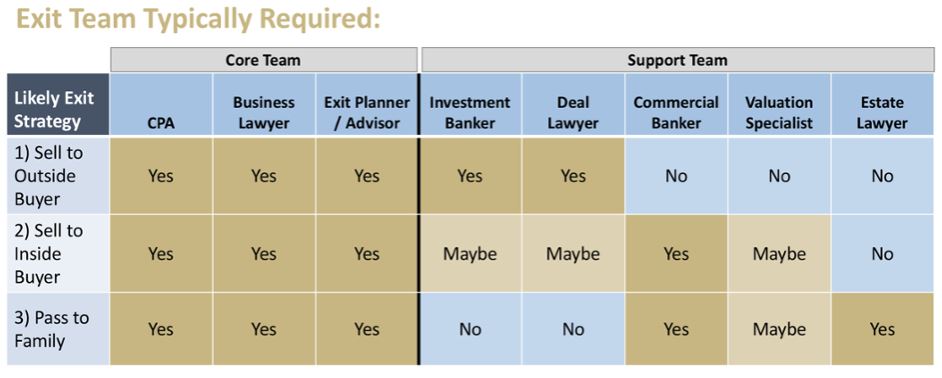
Archive for April, 2018
14 Reasons Not To Share Ownership with Key Employees
Many business owners consider at some point sharing ownership of their business with one or more key employees. Sharing ownership can create powerful advantages—retaining employees for the long-term is usually a top motive. Sharing ownership appears to elevate top employees into a true partnership with you in the ongoing effort to grow the business.
However, sharing ownership is fraught with potential problems. In our experience, it backfires more often than it succeeds. If it backfires, the owner’s ability to successfully exit from the business one day may be jeopardized.
Listed below are fourteen reasons to avoid sharing ownership with top employees, whether you are contemplating selling or gifting to them a piece of your company:
1. Top employees sometimes leave. No matter how loyal and trusted they are, be realistic. It happens.
2. Top employees rarely switch industries. If they leave you, they will likely join or become the competition. Now you have somebody competing with you who owns a piece of your business.
3. To prevent this, you will need to have employees sign an agreement obligating them to sell their stock (or units, if an LLC) back to you should they leave. (This is commonly called a buy-sell agreement.) This arrangement helps avoid a competitor owning some of your company. But, you won’t like writing a check to a former employee to buy back your stock. That’s not fun.
4. Speaking of the buy-sell agreement, sharing ownership with top employees increases governance and legal costs, such as creating and/or updating this buy-sell agreement.
5. Sharing ownership complicates decision-making on critical issues, such as selling the entire company one day. You cannot allow minority owners to hold up a possible sale in the future. This buy-sell agreement therefore also needs to give the majority owner clear authority to sell the entire company, further complicating your exit planning.
6. Sharing ownership bestows rights. Even minority owners have certain rights, commonly including a right to review the company’s financial information and records. You may not be crazy about employees seeing that level of financial detail.
7. Sharing ownership with one or more employees creates a precedent. You intend your company to grow, and that growth in the future may lead to additional valuable employees coming into the picture, either hired from outside the company or promoted from within. Those future top employees may want ownership too, given that their peers already have it.
8. Once a top employee has ownership, it’s easy for the line to blur between ownership and employment. It can become harder to manage an employee who also is an owner. Firing that person, if ever necessary, becomes harder and more expensive.
9. With ownership, come perks. You likely enjoy some personal expenses paid by the company, such as your vehicle, cell phone, meals, etc. Employees who receive ownership often expect to participate in such perks. Either, you will have to include them, which increases costs, or you will have to temper their expectations, which increases your work and their disappointment.
10. With ownership comes responsibilities, such as personally guaranteeing company debt. Top employees who have ownership should not be exempted from sharing in the responsibilities and risks of ownership. It takes additional time and work to explain all of this to new owners, and to include them in a creditor’s underwriting procedures.
11. Occasionally, employees might do things that put themselves and their ownership in the company at risk, such as getting divorced, get sued, or find themselves in financial difficulties.Sharing ownership increases the possibility that your company gets dragged into one of these situations.
12. Sharing ownership complicates your tax and wealth planning. Various strategies that owners use to reduce taxes and build wealth get more complicated with more owners. For example, certain laws regarding retirement plans require owner-employees to be treated differently for anti-discrimination testing. Also, if you have an S-corporation and you wish to make a profit distribution, it must be in proportion to ownership.
13. Sharing ownership dilutes your equity position. That can be more expensive than using cash to incentivize, reward, and retain top employees.
14. Sharing ownership can put your exit goals at risk, particularly if you intend to sell the company. Employees with an ownership interest will receive their portion of the proceeds upon sale. Consequently, you may create a situation where these employees are now flight risks immediately after the sale, if they receive enough cash to contemplate leaving the company.
Because of these disadvantages, we try to accomplish business owners’ objectives without sharing actual ownership. Owners and key employees are often surprised to learn that alternative strategies exist which incent and retain top employees, without the risks of sharing actual ownership. One of our favorite tools to reward, retain, and incent employees involves using golden handcuffs plans in lieu of shared ownership.
There are a few situations where sharing ownership with top employees may make sense. The most common would be sharing some actual ownership now as one step within a comprehensive plan to eventually sell or transfer the entire business to the employees. Otherwise, in most cases, it is advisable to pursue a different course of action.
Call 772-210-4499 or email Tim to schedule a confidential, complimentary consultation.
Two (Surprising) Reasons Why Owners Need an Exit Plan
Why does every business owner need an exit plan? Can’t you just focus on building and growing an excellent company, and the rest will take care of itself?
Ultimately, there are two reasons why just building a strong business is not enough to be assured of a successful exit. These two reasons, based on my experience, best explain why every business owner needs to create and follow an exit plan—years before you intend to exit.
Let’s call the first reason the “Unknown Destination Effect.” Imagine you’re out for a drive, but don’t have a clear destination in mind. Without knowing where you want to end up, it’s impossible to predict if the next left or right turn will eventually lead you to anywhere good. Well, sometimes taking a drive on a beautiful day without a known destination can be fun. But when it comes to your business, generally you want to know where you are going. Leading your company without a clear set of exit goals is the same as driving around with an Unknown Destination. You end up making decisions without knowing if they will lead you anywhere good by the time you get to your future exit.
Here are several examples of important business decisions that, without a clear exit plan, you won’t know which decisions will help or undermine your exit success:
- Which will have a bigger impact on your business’s value at exit – top-line revenue growth or bottom line profitability growth?
- How do you decide to add staff, which can strengthen the team in the future but often decreases profits in the short term?
- Should you trim any under-utilized labor, knowing it may cause current disruptions but can increase profits and potential sale value?
- How do you evaluate a strategic initiative that may contribute to long-term growth but will consume significant current resources and reduce profits?
- Which will produce a bigger impact on business value: vertical or horizontal growth?
- These are important business decisions, that, without an exit plan to follow, you cannot know whether or not your answers will help or hurt you whenever you finally arrive.
The second reason that every business owner needs an exit plan is the law of “Time Increases Results.” This “law” refers to nearly universal truth that the more time allocated to accomplish a goal or project, the greater the probable results. Well, when it comes to achieving exit success, it’s often a surprise for business owners that many of the essential tools and tactics will take years to implement, and/or produce results that positively compound with years of time. In our experience, five years is the critical mark—if your desired exit is five years or less from now, you already may be running short of time to implement specific tools and tactics, and/or you may see significantly diminished results from your efforts.
Here are a few examples of needs that many owners have to address to maximize results at exit, but which can take years to accomplish fully:
- Eliminate any dependency on the business owner for sales, operations, or key relationship management
- Identify, hire, onboard, and align a leadership team that produces a track record of sustained long-term growth
- Outgrow any customer/client concentration
- Create brand value protected in a defensible IP portfolio
- Time market conditions to your advantage
- Evaluate and implement significant exit tax-saving strategies
- Address any misalignment or disagreements between co-owners
- Design and implement ownership and leadership transfer plans (if exiting to key employees or family)
Having a clear, written exit plan helps business owners evaluate and prioritize needs such as these, early enough so that time helps produce and compound positive results.
Put these two reasons together: The “Unknown Destination Effect,” and “Time Increases Results,” and it becomes clear that exit success requires more than just building a good company. The sooner you get started with your exit planning, the greater your likely success.
To discuss your possible strategies, and how to plan for and achieve a successful exit, Call 772-210-4499 or email Tim to schedule a confidential, complimentary consultation.
How One-Way Buy-Sell Agreements Help You Maintain Control When Selling Your Business to Your Employees
When contemplating selling your business to inside buyers (typically one or more key employees), the issue of how and when to give up control becomes critical. You, the current owner, cannot risk giving up control too soon, especially if you are owner-financing at least some of the purchase. On the other hand, the employee(s) buying the company will want to have operational control as soon as possible. Before transferring significant control or actual ownership to employees, consider transferring some of the risks and responsibilities of ownership.
Employees who have never been closely-held business owners may see nothing but the rewards of ownership. They probably were not in the room when you personally guaranteed the business’ debt, skipped a paycheck or two because of tight cash, or agonized over a no-win decision. They probably have not lived through the struggles and sacrifices of ownership. An excellent way to introduce some of the real-world responsibilities of ownership is a One-Way Buy-Sell Plan. In this way, you can share “the insomnia” with your employee-buyer(s).
In this arrangement, enter into a buy-sell agreement with your top employees to purchase the business should you die or become disabled. The agreement is one-way because nothing happens if an employee dies or becomes disabled. Everybody potentially benefits from this tactic. If you are disabled or die, you or your family will receive full payment for the business, and the employees will get the business.
Additionally, the agreement introduces to employees a serious and legally binding commitment—owning a business demands plenty of serious and legally binding commitments. Typically, disability and life insurance are purchased to fund the obligations, just as with a traditional “two-way” buy-sell agreement. Require the employees to pay for some to all of the insurance premiums. This commitment puts the employees’ skin in the game—owning a business requires plenty of skin in the game. If one or more of your key employees will not share in the modest cost of protecting the business and their career options, how comfortable are you that they will be willing and able to purchase the business and make prudent financial decisions once they own it? Some employees who say they want ownership may not be willing to bear the costs and risks that come with the responsibility.
Another benefit of one-way buy-sell agreements is they create an early opportunity to introduce your desire to exit via internal sale without tipping your hand on specific details such as timing. Confidentiality is important, but if you want to sell to these employees, it’s necessary to know as soon as possible if they are willing to buy. By its very nature, a one-way buy-sell emphasizes that you intend to stick around for some time. Otherwise, why bother with the agreement? Approaching employees with the agreement as a risk management tool for today opens the door to a conversation about future exit plans.
To learn more about selling your business to your employees, click the link below to register for our upcoming complimentary webinar: ‘Mission Improbable: The Challenges of Selling Your Business to Your Employees, and How to Overcome Them’
To discuss your unique business, and how to plan for and achieve a successful exit, Call 772-210-4499 or email Tim to schedule a confidential, complimentary consultation.
4 Key Questions to Determine Your Best Exit Strategy
For many owners, determining how to exit is the hardest question. Yet it is essential because the answer identifies the issues and challenges you face and the appropriate tactics you need to consider for a successful exit.
Ben Franklin observed that death and taxes were two of life’s few certainties. We must add a third. Every owner will exit from his business, one way or another. Either during your lifetime or at death, your business will be given away, sold, or liquidated. These three outcomes are not exit strategies. The word “strategy” implies a desirable result. Death is not a strategy!
There are, in fact, four plausible exit strategies. Identifying as early as possible your most likely exit strategy creates a clear path to what is needed to achieve a successful exit.
The four possible exit strategies are:
-
Pass to Family
-
Sell to Outside Buyer
-
Sell to Inside Buyer
-
Planned Liquidation
Notice that selling your business to an outside buyer and selling it to an inside buyer (typically one or more key employees) are different strategies. Conventional wisdom often lumps these two options together as simply “selling the business.” Selling your business to an outside party usually is a completely different process from selling it to one or more employees. We differentiate between those two strategies because the issues and tactics used for each strategy are different.
It is also important to point out the fourth strategy, Planned Liquidation, does not mean failure. Unplanned liquidation could signify failure. Planned Liquidation implies that in a time and manner of your choosing, the business will close in an orderly way. Owners who intend to eventually close down the business still have an acute need for exit planning; they must adopt a current-cash based approach to converting their business wealth rather than a future-equity based approach. Contrary to conventional wisdom, most closely-held business owners need to incorporate some current-cash based tactics into their exit planning and cannot afford just to sit back and wait for a future-equity based payday.
The Exit Strategy Decision Tree
At first, you may not be sure of your likely exit strategy. A process-of-elimination approach often helps identify or solidify your most likely exit strategy. While circumstances and your ultimate exit strategy may change, determining the most likely strategy helps you and your advisors consider tactics to maximize exit results. An exit strategy process of elimination “decision tree” starts with the following statement:
I want family, who have the desire, ability, and youth to succeed me, to one day own my company.
Do you agree or disagree with this statement? If your answer to this statement is “Yes” then your exit strategy likely is to Pass to Family. Each of the four exit strategies uses a short, easy-to-remember (if not, borderline corny) descriptive term. Owners whose likely exit strategy is to pass the business to family are called Passers.
If you said “No” to the first statement, then you must select from the following three statements which best fits your situation. You may have more than one that could fit, but approach this like the standardized tests many of us took in school—choose the answer that “best fits.” Read them carefully, for each statement includes several important details:
My business clearly offers to an outsider Transferable Value significantly above book (liquidation) value.
If this statement best fits, then you have the chance to sell your business to an outside party and be paid for its value as a concern. In this case, you are an Outie.
The next statement reads:
My trusted employee(s) could now, or in the future with preparation, profitably run my business. They also have the desire to own my business and the youth to outlast me.
If this statement best fits your situation, then your likely exit strategy may be to sell to one or more key employee insiders – you are an Innie. Note that there are several important parts to this statement. The employee(s) ideally is trusted, prepared, has the desire, and will be young enough to take over. Remove any one of those factors, and this may not be a viable option for you.
None of these previous statements may seem right for your business. The last statement to consider is:
None of the previous statements fit well. Most likely I will close my business in an orderly manner at the time of my exit.
In this situation, your likely exit strategy may be Planned Liquidation. This owner must consider tactics that use the business’s current cash to convert value along the way. In simple words, squeeze the business dry. If this is you, you are a Squeezer.
Determining whether you likely are a Passer, Outie, Innie, or Squeezer is one of the most important steps in your exit planning. Owners in the four different paths face four different sets of issues, risks, and tactics. Knowing which type of business owner you are, allows you to focus on only those tactics appropriate for your exit goals.
Click here to download our free Exit Strategy Decision Tree infographic.
Read more about the four different exit strategies and the timing to begin your exit planning here.
To discuss your possible strategies, and how to plan for and achieve a successful exit, Call 772-210-4499 or email Tim to schedule a confidential, complimentary consultation.
Your Last Five Years: Where to Go From Here?
You, as a business owner, must answer five critical questions once you reach five years before your desired exit. These five questions define your exit goals and help shape the plan for how you will achieve those goals. As stated in previous articles in this series, there’s no way to sugar-coat this—answering these five questions must happen as you enter Your Last Five Years. Without clear answers, you will not know the steps needed for your exit planning, and you potentially run out of time to maximize your exit success.
This article is the final installment of a seven-part series on what business owners need to do once they reach the Last Five Years before exit.
The five critical questions are:
- What is My Likely Exit Strategy?
- How Much Do I Need to Net From My Exit?
- What Do I Want My Legacy to Be?
- What Do I Want To Do In Life After Exit?
- How Exitable is My Company?
NOTE: Click the article links above to review other installments of the ‘Your Last Five Years’ series
In the previous articles in this series, we explored the five critical questions you as a business owner must answer once you reach five years before your desired exit. As stated in these previous articles, there’s no way to sugar-coat this—answering these five questions must happen as you enter Your Last Five Years. In this last article in this series, we will discuss the remaining steps owners need to take once you reach the point where you intend to exit within the next five years.
Assemble Your Team
Once you arrive at Your Last Five years, it is time to assemble your exit advisory team. Trying to exit without professional assistance is a recipe for failure, and you have only one shot at exit success. First, there will be many highly technical issues to address during exit dealing with legal, tax, accounting, and financial matters. Second, preparing for exit takes hundreds and sometimes thousands of hours of work. You and your management team likely cannot afford to take your eyes off the company ball during the Last Five Years, so outside expert help brings needed bandwidth. Last, if you are selling your company, then your buyer realistically will have more experience doing deals than you and will exploit it against you if you don’t have your team of experts on your side.
Your advisory team can be broken down into two components, a Core Team that every business owner needs, and then a Support Team which varies by your likely exit strategy, as indicated in the chart below. (Remember, selecting your likely exit strategy is one of the questions that must be addressed when you reach Your Last Five Years.)
Once you have your Core Team identified, the next step is to meet with them as a group and share with them your answers to the five questions reviewed in this article series.
Five Exercises to Get Started
Ask any owner who has exited if, in retrospect, he or she would have started getting ready sooner and very likely he or she will advise you to get started planning your exit as early as possible. Once you reach Your Last Five Years, time will become limited and precious. Five years is only 60 months or 1,860 days. It will go by quickly.
Need additional help formulating where to go from here? Consider these final exercises to define your exit goals, and how to get started.
1. Imagine you are looking into a crystal ball, and visualize yourself five years from now, on the day immediately after you have exited. Write down exactly what you wish to see. Be as specific as possible.
2. Write down five outcomes you want to avoid in the course of your exit. Keep the list handy as you go forward.
3. List five people who can help you achieve your exit goals. Set a deadline to speak with them.
4. Describe the top five factors that could undermine your exit success. Review them with your advisory team.
5. Identify the first five people you want to thank as part of your exit plan. Share this list with your close family and advisors.
To discuss your Last Five Years, and how to plan for and achieve a successful exit, Call 772-210-4499 or email Tim to schedule a confidential, complimentary consultation.
 Want to know how this all applies to you? Click here to schedule a complimentary confidential 45-minute consultation with Tim today.
Want to know how this all applies to you? Click here to schedule a complimentary confidential 45-minute consultation with Tim today.






 Tim is a Consultant to Business, Government and Not-for-Profits Organizations specializing in innovative and challenging ways for organizations to survive, to thrive and to build their teams.
Tim is a Consultant to Business, Government and Not-for-Profits Organizations specializing in innovative and challenging ways for organizations to survive, to thrive and to build their teams.